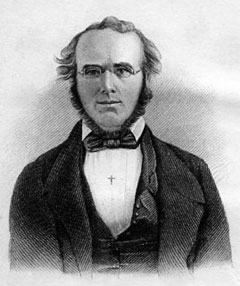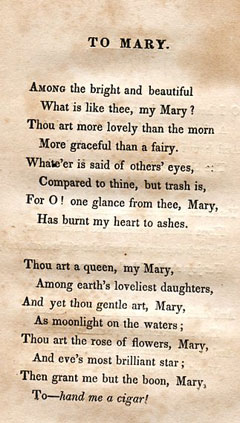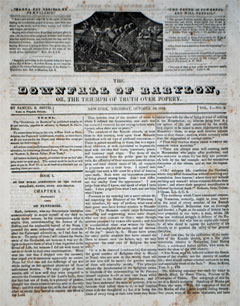American Poet of The 1830s: A Profile In Catholic Creativity
(July 8, 2012)
This profile is a starting point for discovering more about a Catholic poet, author and playwright who was probably little known outside of Catholic New York City even during his lifetime. Charles James Cannon, of Irish parentage, was born in 1800 and died a little over sixty years later.
Cannon was neither an Irving nor a Dickens nor a Wordsworth. His poetry consists of the short rhyming couplets which modern readers find puerile. His plays are "preachy." What makes him intriguing are the times that he lived in and the apparent role that he played in Catholics' struggle for respect and inclusion as fellow Americans.
By the time Charles Cannon's life was half spent, Catholics in the U.S. were experiencing a hatred that they have not had to endure since those remote pre-Civil War decades.
Myths about Catholicism that had been planted in Anglo Saxons in Elizabethan England lived on in their American descendants of the 1830s. The faith was viewed as a criminal conspiracy to subjugate all to a pope who was intent on destroying freedom.
Some Americans during the Revolution had feared that the Marquis de Lafayette would bring priests with his army and forcibly convert the colonies. Now their children saw increasing numbers of Irish immigrants landing at Lower East Side docks as a similar horde invading to make America a papal serfdom.
It was a violent time in which urban riots were common. Mobs occasionally menaced Catholic institutions. In 1834, an Ursuline orphanage in Charlestown, Massachusetts was burned to the ground while police stood by. Fortunately none of the nuns or orphans was harmed.
Religion was a topic of discussion to a degree that is incomprehensible to 21st-Century folk. We avoid the subject, but circa 1830-60 there were countless public debates about the merits of Catholicism and Protestantism. Anti-Catholic societies such as the Friends of Civil and Religious Liberty --no kidding-- were formed.
Technology: faster printing presses, inexpensive paper, new communications including an improving postal service and a uniform currency made print publications cheaper and increased their circulation. A preponderance of printed material was anti-Catholic. Favorites included stories of depraved monks and nuns. The narrator in Edgar Allen Poe's 1842 story, The Pit and The Pendulum is a prisoner of the dreaded Spanish Inquisition.
Catholic children who attended "common schools," forerunners of public schools, were handed "readers" (textbooks) in which it was written that "Luther was raised up by Providence," priests were villains, Irish Catholics went to confession so they could get right back to sinning.
In fact, nascent Catholic schools multiplied rapidly in Eastern cities because leaders such as Bishops John Hughes of New York and John Neumann of Philadelphia concluded that it was futile to rely on institutions run by a protestant establishment.
The education and identity-building effort included publishing, printing pamphlets, prayerbooks, Douay-Rheims Bibles, histories, readers. By the 1840s, Edward Dunigan was issuing all such from his printing press on Fulton Street in New York.
According to scant biographical information about Charles James Cannon, he compiled a spelling-book and a series of readers. Thus Cannon was involved in what Bishop Hughes called "kneading [Catholics] up into one dough." Dunigan printed Cannon's books including The Crowning Hour and Other Poems (1843), a volume which affords us some clues about Cannon's personal life. It seems that Cannon provided cultural stuff along with instructional materials.
Cannon dedicates The Crowning Hour and Other Poems "to my fellow clerks." Writing, as of 1843, was not his day job. "Clerks" were the people who made and kept all the records. He writes of the collected poems having appeared in various periodicals and recalls that one work was hammered by critics. He also mentions an earlier book that "perished in one of the many fires that have, within a few years, done so much injury to our city." It's possible that Cannon self-published, a common practice in those days.
Family life? It's unknown whether he was married or not. One of the poems in the book is entitled "Jersey Jean" :
"And happy is the lowliest flower
that in thy [Jersey's] meadows drinks the dew.
For it may sometimes bask in light
From eyes of deepest, tenderest blue."
Another is addressed "To Mary." What Mary and Jersey Jean thought of each other is one of many things about Cannon that are lost to history,
It appears that Cannon may have been familiar with Edgar Allen Poe. Poe was a master of a new medium of the 1830s, the magazine, made possible by those fast presses and the postal system. Cannon may have even tried to imitate the gloomy Virginian in a poem about a guy who honor-kills his unmarried sister and submerges her corpse in water next to that of her lover. This poem doesn't work and is disconsonant with the Christian vision expressed in all the others.
People and events of the 1830s/40s were subjects of Cannon's pen as well. To The Friends Of Order was written "after one of those outbreaks of popular fury which have so often disgraced our country." It refers to the Charlestown orphange burning among others.
There is a tribute to President William Henry Harrison who died after just 32 days in office. Another pays homage to New York Bishop John DuBois, supporter of St. Elizabeth Ann Seton, who established what is now Mount St. Mary's University.
Cannon must have had a female friend who became a Seton Sister of Charity. The SC's arrived in New York even when Mother Seton was still alive and by the 1830s they were representing her triumphant return to a city that had rejected her.
"The Crowning Hour" is the best of the poems in the book bearing its name. It's about Columbus' discovery of America. Washington Irving's account of that, some of which is quoted as a preface, probably inspired Cannon. The latter's ballad reminds the reader that the America in which Catholics are feared and despised by so many in his lifetime was discovered by a man who was none other than a Catholic himself.
A great writer Charles James Cannon was not, but he made a contribution to a church that, thanks to his contempories, would, in later decades. help transform millions of newcomers into good American citizens. That church would also be a social and cultural force to be reckoned with.
 |
|---|
 |
| A poem with a punchline. Most women probably wish they would hear "Honey, get me a beer," requested like this. |
 |
| An anti-Catholic paper, The Downfall of Babylon, from 1834. The featured author is "Late a Popish Priest" who expounds on how awful nuns are. When he realized how horrible the sisters were, he refused to give them communion whereupon one nun stabbed him with her scissors. Doesn't this sound familiar and half true? |
| Copyright 2012 by Neal J. Conway. All rights reserved. About this site and Neal J. Conway nealjconway.com: Faith and Culture Without The Baloney |